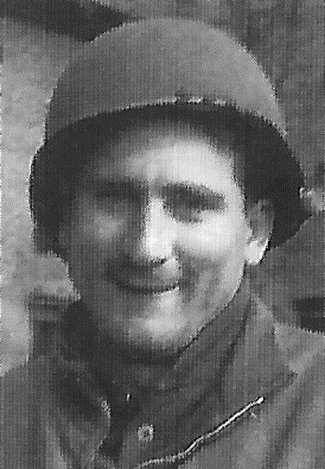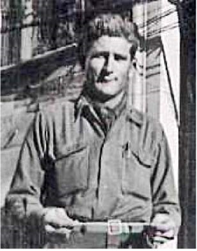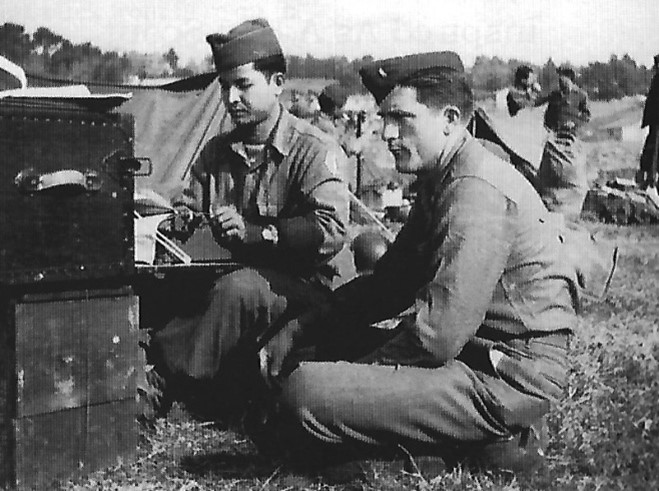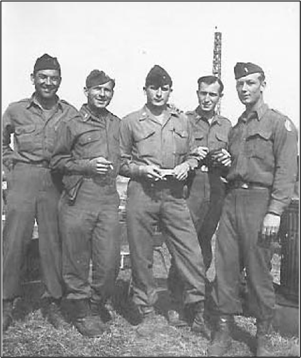
James David Wheatley, Jr.
First Lieutenant
442nd Regimental Combat Team
3rd Battalion, I Company
James David Wheatley, Jr., was born on January 20, 1920, in Rome, Georgia. He was one of two sons and one daughter of James David and Alma (Littlejohn) Wheatley. His father was the Chief Engineer on a steamboat.
Jimmy, as he was known, grew up in Demopolis, Alabama, where his family had moved when he was a small boy. He was active in the Boy Scouts and was a popular football star at Demopolis High School. After finishing school, he operated a service station until he volunteered for the National Guard on November 26, 1939. He served as a Private in Service Company of the local Demopolis National Guard.
On November 20, 1940, the Service Company was federalized and inducted into the 106th Quartermaster Corps, 31st Division. Wheatley was inducted into the Army on this day in Greensboro, Alabama, with over 50 other members of the 106th. He was 5’9” tall and weighed 170 pounds. They were sent to Camp Blanding, Florida, for basic training. The night before they left, the men were guests of honor at a barbeque and dance given by the City of Demopolis.
By late December, Wheatley had been promoted to Corporal. In May 1941, he was sent to the Indian Motorcycle Factory School in Springfield, Massachusetts, to complete a four-week course. On February 7, 1942, he was among 132 men who graduated from the Quartermaster Motor Transportation School at Fort McPherson, Atlanta, Georgia. Their specialized training would enable them to maintain and repair the Army’s fleet of motor vehicles.

In July 1942, Wheatley was stationed at Camp Bowie, Fort Worth, Texas. In the fall of 1942, he was sent to Officer Candidate School (OCS) at Fort Benning, Georgia; graduating as a Second Lieutenant on November 23.
After graduating from OCS, Wheatley was stationed at Camp Robinson, Arkansas. He wrote to his parents at Christmas saying that it was the “first Christmas that I have ever spent away from home…it sure did hurt.” He added that actors Melvyn Douglas and George Murphy were in his regiment and “they make pretty good soldiers.” He signed his letter “Jim,” although the hometown newspaper continued to refer to him as “Jimmy.”
After the 442nd was organized in early 1943, he was sent to Camp Shelby, Mississippi. Beginning with the months of basic training, Wheatley made a sincere effort to know and understand his men. He spent more time with enlisted men than an officer usually did, and as a result he was particularly well liked by his men.
After nearly a year of training, the Combat Team left for Camp Patrick Henry, Virginia, on April 22, 1944. From there they left Hampton Roads, Virginia, on May 2 in a large convoy of troop ships, and arrived on May 28 in Naples, Italy. At this time, he was the leader of the 4th Platoon (which was the weapons platoon of I Company).
After the Rome-Arno Campaign in Italy, Lt. Wheatley was promoted to First Lieutenant and went with the 442nd to France for the Rhineland-Vosges Campaign in the fall of 1944. He was in all of the heavy fighting that took place during the liberation of Bruyères and Biffontaine, and the famous “Rescue of the Lost Battalion.” He wrote home to his parents in December: “…I’m celebrating my Christmas a little early for I have received quite a number of Christmas parcels already. Gosh, it really makes a fellow blue to think of having to spend Christmas over here, but I suppose I shouldn’t gripe for there are many that won’t be able or rather won’t be here for Christmas anymore, so I consider myself lucky…” He continued his letter with the Lost Battalion: “Well, my company was the spearhead of the attack all the way and the first to make contact with them…It was on that push that I got hit.” Wheatley had been wounded in the rescue of the Lost Battalion. He recovered and went with the 442nd to southern France where they joined in the Rhineland-Maritime Alps Campaign (also known as the Champagne Campaign). He was now Acting Commander of I Company. While in southern France, his photo seated at a table in the Grand Hotel in Marseilles appeared in the February 26, 1945, issue of Life Magazine.

Above: 1st Sgt. Clarence Taba and 1st Lt. James Wheatley in Antibes, France, September 1944
In March 1945, the 442nd returned to Italy for the Po Valley Campaign. On April 4 at 10:00 p.m., I Company took off from Azzano and marched to the valley floor before beginning the long climb toward the saddle between Mt. Folgorito and Mt. Carchio from where the attack was to be launched. The “trail” zigzagged constantly upward over the treacherous, shale-covered slope. The men, in full battle equipment, mostly crawled up on their hands and knees or pulled themselves up by a low-growing shrub or the rifle butt of the man above them. By 5:30 a.m. they were at their Line of Departure and the attack was in full swing by 6:00 a.m. On this day, Lt. Wheatley was wounded in his head with six pieces of shrapnel and also in his arm, and he was cited for bravery. Following is the citation;
Silver Star Medal
92nd Infantry Division on September 24, 1945:
For gallantry in action, on April 5, 1945, in Italy. First Lieutenant Wheatley’s company was ordered to take and hold a high peak in the vicinity of Mount Belvedere to secure its battalion’s right flank. When the company was halted by intense enemy small arms, mortar, and artillery fire, First Lieutenant Wheatley proceeded to reconnoiter the hostile positions. He worked his way 200 yards over open terrain under constant sniper and mortar fire to an abandoned enemy bunker on a high mound. He had no sooner reached the position than the foe scored a direct hit on the bunker. Though his carbine was rendered useless and he was wounded in two places, First Lieutenant Wheatley remained to complete his observation. Returning to the company, he directed artillery fire upon the foe, forcing him to abandon a bunker and a machine gun position. When numerous snipers also withdrew, he led the company in seizing the objective. First Lieutenant Wheatley’s aggressive performance reflects great credit on the highest traditions of the Armed Forces.
Lt. Wheatley was sent to the hospital for treatment for his two wounds. He was in the hospital for just over a week and left to return to his unit on the front lines, where he was Acting Company Commander, before he was fully healed.
On April 20, the Combat Team was in the vicinity of Fosdinovo and Mt. Nebbione, which the Germans were fiercely defending. Third Battalion was probing the enemy defenses on Mt. Nebbione from every possible angle, but were consistently beaten back. The men were weary after climbing up and down 3,000-foot peaks for two weeks without much rest.
The following day, April 21, the battalion continued the attack. That night the I Company Command Post (CP) took a direct artillery hit and Lieutenant Wheatley and Pfc. Lloyd Mitsuru Onoye, Acting First Sergeant, were killed.

Pfc. Shuji Taketomo wrote about this incident:
During the day … the meadow next to the I Company location was being shelled. Acting Company Commander 1st Lt. Wheatley organized the command post near a shale mine entrance that afternoon…. about 9:30p.m….there was a big swoosh followed by an explosion. The blast was so great that I was tossed into the air, landing a few feet away from where I had been awaiting my turn to go on guard duty. The impact was amazing, for I had been at least 30 feet from the entrance to the mine shaft.
On Taketomo’s accompanying map (right) he noted that the meadow was about eight acres in size with no trees or bushes, only short grass as ground cover. He noted the location of the Command Post (lower left in map) in relation to the placement of the artillery fire and concluded, “Perhaps that may shed some light upon this incident.”
Sgt. Richard Shinto wrote about this night:
…I Company under Lt. James Wheatley was waiting for an outfit to relieve us. Approximately seventeen of us were waiting in the opening of a mineshaft. It was stuffy and crowded, so I went out for some fresh air. The mine shaft opening took a direct hit; seven to eight men were killed. We lost a lot of good comrades that day.
According to Pfc. Hideo Takahashi:
We lost Lt. James Wheatley and Pfc. Lloyd Onoye in a tunnel explosion. The tunnel was being used as a command post. Since its entrance faced the Allied troops, it is most likely that the tunnel suffered a direct hit from friendly fire.
T/Sgt. Jim Yamashita later recalled:
The saddest assignment was supervising the removal of the bodies of those who had been killed by a direct hit on I Company’s CP at the entry of a mineshaft. Since the shelling had taken place near dusk, only the wounded were taken away and the dead were left in place. The next morning, April 22, 1945, as senior noncom, I had to oversee the removal of the four dead comrades: 1st Lt. James Wheatley, Lloyd Onoye, Eiichi Haita, and Johnny Ogawa. Headquarters had sent up mules and a few Italians as assistants. All I can remember was doing a walk-through; and by then I was so overtaken by what I had seen that I just sat down on a bank near the entrance and barely managed to give instructions as personal effects were brought out. I recall, when asked, telling the Italian detail that they could keep the GI-issue watches.
In May, Lt. Wheatley’s mother received a letter from Col. Virgil R. Miller, commander of the 442nd RCT. He said he was writing with a “deep sense of regret and personal loss.” In explaining the circumstances of her son’s death, he continued, “While advancing with his company and pursuing fleeing enemy troops, he was suddenly killed by a German artillery shell in the mountains of northwestern Italy on the 21st of April. Death was instantaneous and he was thus spared pain and suffering. ‘Jimmy,’ as he was referred to by his fellow officers, was loved and respected by all who knew him. In training and in battle, he was an able and inspiring leader. The soldiers under his command have occasionally expressed their utmost confidence in his ability to lead them through every battle, but now he is gone to rest in that happier world which awaits such men as he. The last tribute that his men can pay to avenge their fallen leader is an avowed and zealous purpose to offer no rest for a weary enemy until he is utterly destroyed.”
Mrs. Wheatley also received a letter from her son’s Battalion Chaplain, Captain Masao Yamada, in which he said: “…we knew him and loved him in our unit. He was respected very highly by his men and officers. He was actually the most courageous of our commanders. There was no mission he would not share with his men. Often, he was at the head of his company or patrol in making hazardous marches. He never failed his men. As Company Commander, Lt. Wheatley was awaiting movement orders in a well-concealed tunnel…A single mortar shell landed squarely in the tunnel through a small opening. The fragments wounded him fatally on his legs, arms, and body. Medical aid reached him immediately, but death had overtaken him almost instantaneously.”

First Lieutenant James David Wheatley, Jr. was interred in the U.S. Military Cemetery at Granaglione, Italy, in Plot D, Row 9, No. 530. The Division Chaplain’s Office conducted a graveside service.
On Armistice Day, November 11, 1945, the First Baptist Church in Demopolis held a memorial service in honor of veterans of World Wars I and II. The service was dedicated to 1st Lt. Wheatley. He was survived by his parents, brother Arthur Wheatley, sister-in-law Pauline, sister Nina (Mrs. Eldred) Barger, niece Margaret Irene Wheatley, and nephews – Arthur James Wheatley, Jr.; and Eldred (“Sonny”) and James (“Jimmy) Barger. Jimmy was named for his uncle.
Above: L-R: I Company Lieutenants James B. Dunn, Roy Gerkovich, Jim Wheatley, George Halpin, and Charles A. Hines
For his military service, First Lieutenant James David Wheatley, Jr., was awarded the Silver Star Medal, Bronze Star Medal, Purple Heart Medal with four oak leaf clusters, American Defense Medal, American Campaign Medal, European-African-Middle Eastern Campaign Medal with four bronze stars, World War II Victory Medal, Distinguished Unit Badge, and Combat Infantryman Badge. He was awarded the Congressional Gold Medal on October 5, 2010, along with the other veterans of the 100th/442nd Regimental Combat Team. This is the highest Congressional Civilian Medal.
In 1948, the remains of Americans buried overseas began slowly to return to the US, if the family so wished. The first week of November, the Wheatley family received word that Lt. Wheatley’s remains would be brought home. His remains arrived in the US later in November and were accompanied from Atlanta to Demopolis by Captain Burdette, who was the U.S. Army escort officer assigned to assure Lt. Wheatley was returned home in full honor and dignity. A military funeral was held in Demopolis on November 24 at the First Baptist Church under the auspices of the Bigbee-Warrior Post of the Veterans of Foreign Wars and the Mercer-Braswell Post of the American Legion. A graveside service was held at his interment in Riverside Cemetery. Eight servicemen from nearby Craig Field in Selma attended and formed a firing squad for the three-gun salute, followed by Taps.
Mr. and Mrs. Wheatley kept in touch with several I Company men over the years. After their son was reburied in Demopolis, one of the men, former Pfc. Sam Tando, with his wife and son, arrived from Chicago with a large floral wreath and visited Wheatley’s gravesite and the Wheatley family.
In 1976, Lt. Wheatley’s brother and sister-in-law, Arthur and Pauline Wheatley, attended a Nisei Veterans Reunion. They were given a memorial plaque (photo below) inscribed: In loving memory of Lt. James D. Wheatley Jr. Killed in action on April 21, 1945 in the vicinity of Fosdinovo, Italy. Remembered for his courageous, efficient leadership and comradeship. Men and Officers of Co. I, 442nd Infantry Japanese American Regimental Combat Team.

Researched and written by the Sons & Daughters of the 442nd Regimental Combat Team in 2021.
